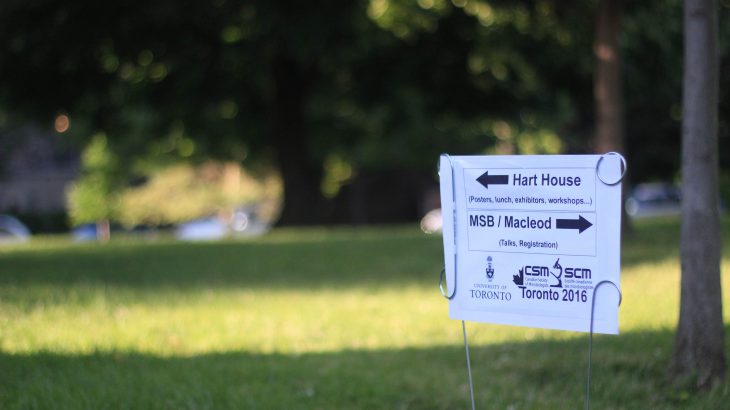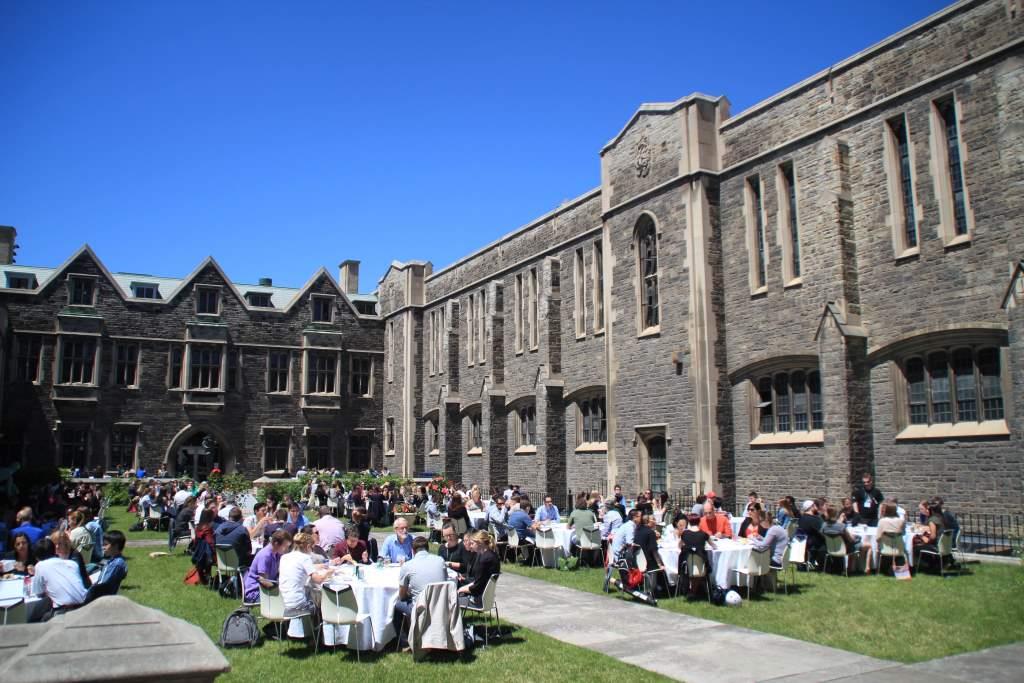By Betty Zou
What do the scientific breakthrough of the year, fecal transplants and pea plants have in common? Microbes!
The newest research in these and many other areas was showcased recently at the 66th Canadian Society of Microbiologists (CSM) annual conference, which took place at the University of Toronto on June 12 to 15, 2016. The subjects may be microscopic but their impact is anything but. The conference covered a broad spectrum of topics including: microbial communities in diverse natural and built environments; novel strategies in identifying and testing new antimicrobial compounds; and molecular and genetic insights into bacterial defense against viruses and other bacteria.
Here are some highlights:
Using boreal shield lakes to study ancient oceans
During the Archaean Eon some 4,000 to 2,500 million years ago, Earth’s oceans were not as hospitable as they are today. Archaean oceans had high levels of iron, low levels of sulfur and no oxygen, making them hostile to nearly all forms of life. Yet it was in these waters that life is thought to have begun. In his talk, PhD student Jackson Tsuji presented the first evidence that boreal shield lakes can serve as Archaean ocean analogues for microbial experimentation and analysis. Boreal shield lakes are found in Canada, Russia and parts of Scandinavia. The lakes have naturally high iron and low sulfur content and at certain times of the year, the bottom portions become depleted of oxygen. The lakes that Tsuji analyzed are part of the International Institute for Sustainable Development Experimental Lakes Area (IISD-ELA) in northern Ontario. Using DNA sequencing, he showed that the microbial community in these lakes was dominated by photosynthetic bacteria that use iron to turn light into energy. Tsuji also found evidence of methane- and sulfur-metabolizing bacteria in the IISD-ELA waters. The microbial community he studied is similar to other Archaean ocean analogues, and to microbial communities thought to have existed in the ancient oceans.
Jackson Tsuji presented the first evidence that boreal shield lakes can serve as Archaean ocean analogues for microbial experimentation and analysis.
To date, only four lakes worldwide have been identified that have chemical and physical properties comparable to Archaean oceans. Unlike these lakes, the IISD-ELA lakes are numerous and easy to access, have long-term data records and can be experimentally manipulated – factors that make them ideally suited for this research. “These lakes enable us to not just verify findings from existing analogues but also to make and test hypotheses that would be relevant to how life on Earth would have arisen,” said Dr. Josh Neufeld in an interview with Science Borealis. Neufeld is Tsuji’s supervisor and a professor in the Department of Biology at the University of Waterloo. “Without them, we’re stuck with flasks in a lab.” Tsuji will be heading back to the IISD-ELA next week to collect water samples along the depth profiles of five different lakes. In addition to cultivating bacteria isolated from these samples, his goal is to complete a more comprehensive genetic analysis of the different bacterial and archaeal species present in those waters.
Participants at the 2016 CSM conference enjoy a lunch break in the beautiful Hart House quad. Photo: Senjuti Saha
An animal model for gonorrhea and HIV co-infection
Data from laboratory, clinical and epidemiological studies have revealed synergy between the sexually transmitted infections gonorrhea and HIV. Infection with the Neisseria gonorrheae bacteria drives HIV replication and increases the amount of virus shed from the body, thereby enhancing transmission. People with gonorrhea are also at higher risk of contracting HIV, likely as a result of the inflammation caused by N. gonorrheae. “When you have something that’s inflammatory and causing damage in the genital tract or urethra, you’re going to make yourself susceptible to infection,” said Dr. Stacey Xu, a postdoctoral fellow in the lab of Dr. Scott Gray-Owen at the University of Toronto. At the CSM meeting, Xu described her work creating the first ever mouse model to study gonorrhea and HIV co-infection.
The newly transplanted stem cells enabled the mouse to develop an immune system that generated a human-like immune response to HIV infection.
Despite the wealth of data pointing to a link between the two pathogens, research on how they interact with each other and the consequences of those interactions has been hampered by the lack of a good animal model. That’s because both HIV and N. gonorrheae are human-specific pathogens exquisitely adapted to recognizing and infecting human cells. Xu began her work in a humanized mouse that was engineered to have the specific human cell components that allow HIV and N. gonorrheae to establish an infection. She then gave the mouse a chemotherapy drug to eliminate its immune system in preparation for a stem cell transplant. The newly transplanted stem cells enabled the mouse to develop an immune system that generated a human-like immune response to HIV infection. While this work is still in its early days, Xu hopes that her model will allow researchers to better understand the mechanism underlying gonorrhea-HIV interactions, especially in the context of vaccine development.
How E. coli knows it’s in your gut
Some types of Escherichia coli like enterohemorrhagic Escherichia coli (EHEC) can cause severe food poisoning with symptoms like abdominal cramps and bloody diarrhea. Fewer than 500 EHEC bacteria are enough to cause an infection, which is impressive when you consider that the small intestine, its preferred site of colonization, is already home to a robust bacterial ecosystem collectively known as the gut microbiota. In order for EHEC to cause disease, it must figure out where it is and establish a foothold in this crowded environment by engaging with the native gut bacteria. “We really want to get at how the bacteria [are] interacting with each other directly. What are the microbiota producing that the pathogen might be sensing?” said Dr. Stefanie Vogt in an interview with Science Borealis. Vogt is a postdoctoral fellow in Dr. Brett Finlay’s lab at the University of British Columbia.
In order for EHEC to cause disease, it must figure out where it is and establish a foothold in this crowded environment by engaging with the native gut bacteria.
To answer those questions, she isolated the waste products from a group of bacteria normally found growing in the human gut and added them to growing EHEC to see what genes were turned on or off. In response to these chemical signals, EHEC turned on genes that help them deal with stress and shut down genes for making biotin, also known as vitamin B7. Vogt hypothesized that biotin could serve as a cue to EHEC that it’s in the right spot in the gut and help it outcompete the native bacteria, an idea she is now testing in the lab. “We know that EHEC can sense biotin and take it up so we’re looking into whether EHEC’s ability to use this microbiota-produced biotin might give it a growth advantage,” said Vogt.
Other highlights
Other notable highlights from the conference include several talks on how bacteria use the CRISPR system to defend against viral attacks and how these viruses evolved different anti-CRISPRs to overcome bacterial defenses. CRISPR is often in the headlines because researchers have adapted it into a genetic tool that enables them to edit genes with remarkable ease and precision. Before it was Science magazine’s breakthrough of the year, however, CRISPR was used by bacteria to protect themselves against invasion by viruses.
These realistic petri dish keychains are handmade with resin and paint by the Waterloo-based small business Micrelle. Micrelle specializes in microbiology novelties including Christmas ornaments and fridge magnets. Photo: Senjuti Saha.
With the Twitter hashtag #AllMalePanels trending over recent months, it was refreshing to see modern gender representation at the CSM conference. Of the 19 invited speakers, 8 were women including early-career scientists with new labs.
Another delightful touch by the conference organizers was the inclusion of science artists in the exhibitor hall. Vendors sold handmade science art from microbiology-themed jewellery and prints to nerdy greeting cards. It was fascinating to see how science and art can come together in fun and creative ways.
As the conference wrapped up, the organizers of next year’s event took to the stage to welcome attendees to the 2017 CSM conference at the University of Waterloo. With promises of beer, bratwurst and Ed Yong as a keynote speaker, next year’s gathering is sure to be a memorable one. See you there!
Header Photo: Senjuti Saha






